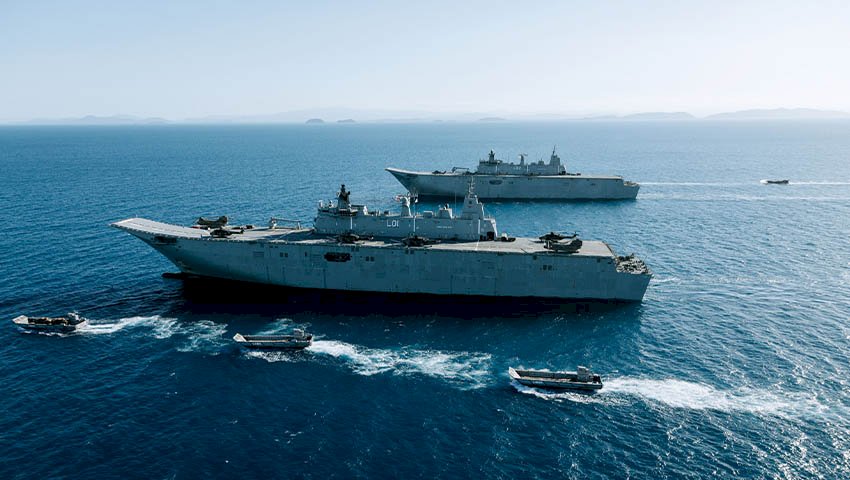The Royal Australian Navy and Its Sealift Capabilities: Do They Need to Be Ramped Up?
Planning for the Royal Australian Navy’s two Canberra Class landing helicopter dock (LHD) ships were initially based upon the nation’s experiences with the International Peacekeeping Force activities in support of East Timor.
The difficulty in sustaining an expeditionary force to one of Australia’s nearest neighbours quickly demonstrated the need for an improved amphibious sealift capability above the then existing structure…..
Now with HMA Ships Canberra and Adelaide in full commission as the fleet’s major amphibious units, will ADF planners now re-consider beefing up the LHD’s aircraft suite with larger rotary machines to expand the capabilities of the vessels in their various peacetime or wartime operations?
Such helicopters would be integrated into the Fleet Air Arm list of equipment and be crewed, controlled and operated solely by RAN personnel.
A purchase of six larger transport helicopters would provide two aircraft per ship, one aircraft in maintenance, and the sixth for crew training and/or in standby for rotation for aircraft going into heavy maintenance.
These aircraft would substantially boost the LHD’s operational capacities, with their ability to lift and transfer larger and heavy loads (including personnel transfers) in a much shorter time parameter…..
The selection of the MRH-90 shared between Navy and Army appears to be a comfortable fit for the LHDs, however in a combat exigency situation when equipment and support stores for landed troops is a priority, an aircraft with a lot more grunt is required to handle the increased demand.
With a combined 22,500hp surging through its three turbines – roughly 50 per cent more power than its predecessor – the helicopter’s top speed will near 200 knots. The triple engine King Stallion main advantage is size, and with its folding tail boom it will fit on amphibious warfare ships for a better performance. Initially, that’s why the Sea Stallion existed, and why the smaller Sea Knight was the same tandem configuration as Chinook. If you don’t have the space limitation you don’t care, you buy the CH-47 Chinook because it can accomplish the missions you need while being extensively supported world-wide.
The CH-53K King Stallion is considered the most modern and advanced heavy-lift helicopter in the world today….
Short of an initial outlay of millions of dollars for the six heavy-lift aircraft, it could be vindicated in Defence (Navy) initially leasing three aircraft (one for each LHD and another as a back-up/training aircraft) for a three-year period and with an option of a two-year extension, for flight and ground crews to be selected and trained in the operations of the new model.
It would be deemed more applicable, in the first instance, to lease three of the older CH-53E Super Stallions as these aircraft already have an operationally proven track record (with most of the bugs ironed out) and are in active service with the USN and would be an ideal introduction platform for the new RAN crews in which to gain experience over the five-year period.
Throughout the proposed RAN lease period with the CH-53E Super Stallion, the CH-53K King Stallion would unquestionably have undertaken additional hundreds of flight hours in testing, training, upgrading and implementing the multitude of snags emanating from this new aircraft before Defence (Navy) decide upon the purchase with the newer aircraft.
Conversely, the decision could be made to retain the CH-53E Super Stallion after the lease period was over….
Steve Chaplin joined the RAN in 1965 as a Junior Recruit and went on to become a Weapons Mechanic. Chaplin served on HMAS Parramatta and participated in the march out Guard in Labuan in 1966 at the cessation of hostilities in Borneo.
Chaplin also participated in the commissioning of the DDG HMAS Brisbane, underwent intensive course instruction in Dam Neck, Virginia, on the gunnery system 5”54 and also served in the ships first deployment to Vietnam.
For the complete article, see the following:

